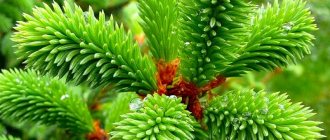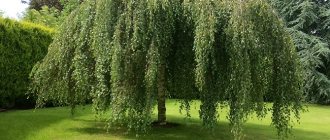A corner of paradise, where everything around is fragrant and pleasing to the eye... Is this how you want your garden to look in moments of relaxation?
It’s a completely understandable desire, and we’ll tell you how to make it come true. How to turn your plot into a fragrant paradise?
A breath of fresh air is our first impression after a flight when we arrive at a distant resort. At these moments we feel the changes especially acutely - the south greets us with aromas. Having reached the final point of the journey, we see that it could not be otherwise: not only the flowers are fragrant, but also the trees and shrubs.
Sources of pleasant odors do not always reveal themselves at first sight. Sometimes you have to come close to see small and not very interesting flowers or be surprised to discover that it’s not the flowers that smell, but the leaves or pine needles. Northern nature is poorer in aromas, but in the garden we can collect them into a “bouquet” sufficient to turn a summer cottage into a fragrant paradise.
What is needed for this? It would seem that everything is very simple: plant more fragrant plants. But remember: pinpoint “inclusions” of aromas will dissolve in space, so it makes sense to “increase the concentration.” It is clear that the contribution from a hedge of lilac or jasmine is incomparably greater than from a separate bush, and the aroma from a wide strip of snowdrops and corydalis planted under it spreads further than from a small curtain in a flowerbed.
Important : each fragrant plant has its own “critical mass” at which it is able to make itself known from a distance. It is this factor that is worth focusing on.
Crown jasmine or garden jasmine (Philadelphus coronarius) is an excellent choice for a fragrant hedge.
There is one more important nuance: most often, we are primarily attracted by the beauty of plants, and not by their aroma. Therefore, when creating a fragrant corner, we are faced with a contradiction, discovering that our favorite plants sometimes try to slightly deceive us, not meeting our expectations. But this problem can be corrected, because the same garden crop is often represented by both fragrant and odorless varieties. On the one hand, peonies, lilies and roses also have varieties without fragrance, which in our minds “should” be fragrant.
On the other hand, pleasant surprises also happen where we don’t expect them. For example, in a sea of scentless tulips, there are masterpieces not only in beauty, but also in aroma.
Advice: without giving up your favorite plants, find among them varieties that, by more fully affecting the senses, give rise to more pleasant emotions. Among the beauties of lilies (on the left), the most fragrant are oriental hybrids. It is better to buy tobacco and heliotrope (on the right) as seedlings, then you definitely can’t go wrong with the choice of variety
Night violet
Two-horned matthiola
Night violet or two-horned matthiola is an outwardly inconspicuous flower that gardeners may not like at first. But its strength is not in its beauty, but in the incredible sweet smell that spreads around the garden in the evening. The incredible scent of night violet lasts until the morning. This flower, which smells pleasantly of honey, will delight the eye throughout the summer. This unpretentious plant is not even afraid of the first frost.
It is recommended to sow two-horned matthiola directly into the soil in the spring. Night violet feels great in sunny areas, but can also develop well in shaded areas.
List of fragrant annual flowers that can be sown as seedlings
Fragrant annual flowers with a pronounced aroma are a delight not only for our eyes, but also for our sense of smell. If at the end of winter and in the first half of spring you devote enough time to sowing annuals for seedlings and caring for seedlings, then in the summer you can enjoy the fragrance of a fragrant garden at your dacha.
Heliotrope
Heliotrope is an amazing flower that boasts not only an attractive appearance, but also an aroma. It is because of the pleasant smell that the flower crop is used in the perfume industry. Heliotrope exudes aroma during the daytime. An interesting feature of heliotrope: its inflorescence turns after the sun. In our conditions, it is grown as an annual, although it can be grown as a perennial in a container and brought into a warm room for the winter.
It is optimal to sow heliotrope for seedlings in late February or early March. The seeds are evenly distributed in the box over the soil layer and covered with soil 1-2 millimeters thick on top.
Matthiola bicornuum
Matthiola bicorne has a completely unremarkable appearance, because it has pale, small, inconspicuous flowers, pale pink, lilac or white. But the amazing spicy, sweet aroma of the annual compensates for all external shortcomings and makes you fall in love with the evening garden! The flowers smell very pleasantly and richly in the evening and at night. A member of the cruciferous family blooms throughout the summer.
As a rule, this aromatic crop is planted directly in open ground. But if you sow matthiola bicornuum as seedlings at home, you can enjoy flowering 2 weeks earlier. You can sow in mid or late March. Before sowing seedlings, it is recommended to place the seeds on a damp cloth or cotton pad in the refrigerator for 3-4 days for stratification. The soil mixture should not be very fertile. It is convenient to plant in a common shallow, wide bowl. The seeds are scattered over the surface and sprinkled with river sand or earth, the layer thickness is about 3 millimeters.
Mattiola gray (Levkoy)
Mattiola gray (or Levkoy), as well as its relative Mattiola bicorna, has a pleasant aroma that opens at night . However, its smell is weaker, but its appearance is much more attractive. There are white, pink, lilac, yellow colors of double, bright flowers.
It is optimal to sow gilly leaves for seedlings in the second half of March. It is susceptible to blackleg disease, so it is necessary to disinfect the soil. Sowing of matthiola hoary seedlings is done as follows: the seeds are distributed over the surface of the substrate, covered with soil or sand on top with a layer of 3 mm.
Sweet pea
Annual sweet peas are distinguished by their decorative appearance and pleasant vanilla aroma. Smells fragrant during the daytime. Delicate flowers, similar to small orchids, can be pink, lilac, red, blue. Low-growing varieties of peas can be planted along the borders, in a mixborder. And tall varieties of sweet peas are perfect for vertical gardening, for example, you can decorate various supports (various trellises, small arches).
The time for sowing sweet peas for seedlings is usually in the first half of April. For better and faster germination, it is recommended to prepare the seeds: soak them in warm water for 10 hours or in a growth stimulator according to the instructions, you can also germinate them (put them in a bag on a damp cloth and put them in a warm place). You need to sow immediately into individual cups or cassettes with a volume of 200 ml. The seeds are immersed in holes 2 cm deep and covered with earth on top.
Note! Perennial sweet peas do not have a strong odor.
Fragrant tobacco
Sweet tobacco (or Winged tobacco) is a relative of smoking tobacco, but it is grown exclusively for decorating and flavoring the garden. The fragrance of the annual begins in the evening and lasts all night. The flowers are also attractive and can be white, pale green, pink, red, or purple (with white and lighter flowers smelling stronger!). Height varies from 0.3 to 0.8 m. Winged tobacco blooms all summer. In addition to its pleasant aroma and delicate flowers, the annual in the garden plays the role of an insecticide and repels pests.
It is optimal to sow fragrant tobacco for seedlings at the end of February, in March. Since the seeds of the crop are very small, it is most convenient to first plant them in a common shallow box and then pick them up. Sowing is superficial, that is, the seeds are simply scattered over the surface of the substrate and are not covered with anything on top.
Mignonette fragrant
Fragrant mignonette has a completely inconspicuous, inexpressive flowering. Small, pale yellow-green flowers rarely attract anyone's interest. However, it boasts an amazing and unique aroma; with the help of mignonette, you can turn an ordinary plot into a fragrant garden. The fragrant aroma reveals itself in the daytime. To beautifully scent a dacha or area of a private house with this plant, it is recommended to plant it among variegated flowers. Thus, you can get an interesting, beautiful and fragrant flower garden.
The time for sowing fragrant mignonette for seedlings at home is at the beginning of March. Seeds are planted one at a time in an individual cup with a diameter of about 15 cm. The seeds are covered with a 2 cm layer of soil on top.
Alyssum (Lobularia marine)
Alyssum or Lobularia marine exudes a pleasant sweet honey aroma. Also, the annual ground cover crop boasts small graceful flowers and long flowering. Alyssum is fragrant during the daytime. The plant attracts bees and other beneficial insects to the garden. It looks best on an alpine hill, in a rock garden, as well as in a regular flower bed. The plant reproduces well on its own through self-seeding in open ground.
You can sow alyssum for seedlings at the end of February or in the first half of March. It is better to sow in slightly alkaline soil and a wide, shallow bowl. On the surface of the soil you need to make grooves 0.5 cm deep at a distance of 3 cm, the seeds are sown in the groove with an interval of about 1.5 cm. The seeds are covered with sand on top.
Gray-haired matthiola
Gray Levkoy or Gray Mattiola
These fragrant flowers for the flowerbed are also called gray Levkoy. The plant has a pleasant aroma of honey, as well as double flowers that bloom in the shape of a hat. The height of the crop is up to 80 cm, there are also dwarf varieties - their height is no more than 20 cm. The flowers can be either regular or double. Flowering lasts for a month. The plant is planted only through seedlings, this allows you to get beautiful seedlings and flowers.
What types should I use? Fragrant garden plants
Pleasant-smelling annuals and perennials
One of the most famous fragrant aromatic plants is Levka . Gives off an amazing, pleasant aroma, especially in the evening. In addition to this, several other species deserve attention.
Levkoy, or Matthiola (lat. Matthiola)
Description : usually reaches 30-40 cm in height, flowers are small from white to mauve or yellow with four petals. They emit an intense odor especially in the evening and at night;
Flowering : from July to September;
Application : for any type of garden, on the balcony, on flower beds, under the window.
Sweet pea (lat. Láthyrus odorátus)
Description : climbing annual, can grow up to 2 m in height, forms small elliptical leaves. The flowers are irregular, quintuple type, can have different colors - most often they bloom in white, pink and purple. It is grown for its fragrant aroma, which gives it its name.
Flowering : from June to August;
Application : decoration of fences, for all types of decorative trellises, can be planted in a flower bed.
Lakfiol or Cheri's jaundice (lat. Cheiranthus cheiri)
Description : biennial plant, as a rule, reaches 50-60 cm in height. A plant with large yellow, orange, purple, velvety brown and variegated cruciferous flowers;
Flowering : from April to June;
Application : on balconies, on flower beds, for cutting flowers.
Decorative tobacco (lat. Nicotiana alata)
Description : perennial plant, grows to 50-80 cm in height. The leaves are elongated, small, the flowers are collected in an inflorescence - a panicle, open at night and then smell most intensely. Their color can be white, pink, cream;
Flowering : abundantly from June to October;
Application : flower beds, growing in containers, decorating fences.
Fragrant, aromatic bulbous and perennial plants
Bulbs and perennials generally emit a pleasant aroma, but some species stand out from others. In the group below we couldn’t ignore such favorites as hyacinth, lily of the valley and lily.
Lily (lat. Lilium)
Description : depending on the variety, they can be of different heights, usually no more than 150 cm. The decoration is large, with bent tops, tubular or cup-shaped flowers of various colors. Lilies emit a strong, almost suffocating odor;
Flowering : mainly in summer;
Application : for flower beds, for individual parts of the garden.
White ash tree (lat. Dictamnus albus)
Description : can grow up to 120 cm in height. The leaves are large, odd-pinnate with serrated edges. The flowers are large, collected in racemes. The entire plant emits a lemon-like aroma. On hot sunny days, essential oils can ignite. A blue flame appears for a short time, but does not damage the plant.
Flowering : June – July 40-45 days;
Application : for flower beds, planting in groups, for naturalistic and rustic gardens.
Hyacinth (lat. Hyacinthus)
Description : the plant reaches about 20-30 cm in height. The decoration is large flowers collected at the top of the stem in the form of a brush. Their color depends on the variety (most often they bloom in white, blue, purple, pink and red). Hyacinths emit an intense, slightly suffocating aroma;
Flowering : from March to May;
Application : for flower beds, rock gardens, for pots, for decorating apartments - on the windowsill.
May lily of the valley (lat. Convallaria majális)
Description : This is a low plant, about 20 cm high. The decoration consists of both small, bell-shaped white flowers forming an inflorescence and large lanceolate leaves;
Flowering : from May to June;
Application : flower beds, ground cover, cut flower, rustic garden.
Peony (lat. Paeonia)
Description : depending on the type, it can reach 80-120 cm in height. Produces large, feathery leaves and attractive white, pink, red flowers. Flowers can be 15-20 cm in diameter. Peonies are also loved for their pleasant aroma;
Flowering : May - June;
Application : for single or group plantings, in high flower beds, for the park, for cutting flowers.
Fragrant tobacco
Fragrant tobacco
Another fragrant flower for the garden is fragrant tobacco. They look great both in flower beds and in pots. These fragrant flowers for the balcony are annuals, distinguished by long stems, white buds, and bloom in the evening. There are also many compact varieties, the petals of which are painted in raspberry, red, pink, lemon-yellowish shades. But the most pronounced smell is only in flowers with white buds.
Tobacco is grown using seedlings, which guarantees early flowering of the crop. Flowers are afraid of frost, so it is better to leave planting tobacco until real warmth arrives. The culture prefers areas with a lot of sunlight. Sometimes the plant is saved until the next season; for this, it is dug up and planted in pots, placing it in the basement. When spring comes, the dug-out crop returns to its original place.
Garden plants with wonderful aroma
Although many plants emit a strong and enchanting scent when they bloom, only a very few species act as natural perfumes that can be perceived from a distance. It is worth paying attention to this property, because in a fragrant garden . It has long been known that the smell of flowers affects well-being and health.
A garden in which the amazing aromas of flowers and greenery mix together is a dream that can easily be realized. There is a certain group of plants that emit an intense aroma that captivates not only insects, but also people. It is worth using this and choosing fragrant plants, especially since such species are at the same time extremely attractive and easy to place in gardens of various types. The smell of flowers can also have a beneficial effect on health - it has an anti-stress effect and improves mood.
Fragrant plants - where to plant?
Obviously, it should be understood that not every plant emits such a strong odor to please the sense of smell while walking around a large area of the garden. Therefore, fragrant plants should be planted in certain places:
- near the house on the windows (then the aroma can be felt even while in the house);
- near benches and other architectural elements such as terraces or gazebos;
- on the balcony;
- in places where there is already an unpleasant odor, for example, near a composter;
- trees and shrubs can be used as barriers from busy roads. In addition to the pleasant smell, the below-mentioned species can additionally form a dense wall, limiting pollution and noise to some extent.
Sweet pea
Sweet Peas
You can get wonderful evening garden scents by planting sweet peas. More than 100 varieties of this crop are known, there are varieties with large and small flowers, they are distinguished by different shades of petals. The bright smell is most characteristic of early varieties.
This type of vine is perfectly fixed to various supports and pergolas, so it is actively used for vertical gardening. Low-growing representatives look great in hanging baskets or containers. Sweet peas do not like transplanting, so it is recommended to plant them immediately in warm soil.
Phlox
Almost all varieties of phlox have a light, unobtrusive aroma throughout the day. However, towards evening the smell becomes clearer and more concentrated. Whichever of the many varieties of this plant you choose, it will definitely not disappoint you.
- Popular types and varieties of perennial phlox
5 types and 21 varieties of phlox for every taste.
If you know at what time of day the scent of a particular plant reaches its peak, then you can easily create compositions that would emit aroma precisely at those hours when you are on the site most often. You can even set up your own aromatherapy corner that you can visit at any time.
Mignonette
Mignonette
Another fragrant flower is mignonette. The most famous varieties are “Victoria”, “Mashet”, “Ruby”, “Goliath”. Color: red-green, yellowish, dark brown, light green. Mignonette is planted in late April or early May. How mignonette sprouts depends on soil moisture and weather conditions. The first shoots are observed after 1-2 weeks. The culture prefers free space, so it must be thinned out. To grow plants, choose areas that receive good sunlight.
Names of perennial fragrant flowers for sowing seedlings
Not only annuals can boast an interesting aroma; there are also perennial flowers with a pleasant aroma. What kinds of fragrant perennials there are and how to sow them for seedlings can be seen below.
Lavender
Lavender is a well-known and popular plant all over the world; it has captivated many gardeners with its delicate, characteristic aroma and beautiful lilac flowers. It is worth planting lavender in your area not only to flavor the garden, but also to decorate the area. The perennial culture looks very good in rock gardens and alpine hills. Also, the fragrant perennial can be grown in a pot or flowerpot and used to decorate a terrace, balcony, or gazebo.
It is better to sow lavender for seedlings in the second half of February, in the first half of March. But when choosing the timing, keep in mind that the seeds of this crop need stratification (45-30 days are kept in the refrigerator in moist soil or fabric). When planting, the seeds are distributed over the surface of the soil at intervals of 2-3 centimeters, and sprinkled with calcined river sand on top (a layer of 3 millimeters).
Mirabilis jalapa (Night Beauty)
Mirabilis jalapa (or Night Beauty) opens its flowers and begins to smell fragrant in the evening and until the morning . There are flowers of pink, red, yellow, white, and orange. Also, the colors on one flower can be mixed. The aroma of the plant is very delicate, delicious and unobtrusive. Mirabilis jalapa is a perennial, but in regions with cold winters it is grown as an annual plant, and it reproduces well by self-sowing without the participation of a grower.
It is optimal to sow Mirabilis jalapa for seedlings in the second half of March or early April. Since the seeds of the night beauty have a dense shell, they must first be germinated. To germinate, you need to put them on a damp cotton pad and cover with the same damp disc on top, place them in a bag and maintain moderate humidity. Typically, it will take several days for germination to occur. Mirabilis is sowed in individual cups. In one glass you need to put 1 or 2 seeds to a depth of 1 cm.
Evening Matrona (Hesperis, Night violet)
Matrona's Vessel (or Hesperis, Night Violet) is valued primarily for its subtle, sweet scent. It smells fragrant in the garden in the evening and at night. It is rarely planted solely for its decorative properties, because hesperis blooms modestly. The plant is biennial or perennial. It reveals its potential especially strongly in moist, nutritious soils.
Matrona fragrant noctule is planted for seedlings in early April. Seeds are sown evenly over the surface of the substrate in a common container, sprinkled with soil 5 millimeters thick on top.
Advice! Do not plant different fragrant crops too close to each other so that they do not interrupt the aroma or create a tandem that smells too strongly and aggressively.
Unfortunately, it is impossible to convey the aroma of fragrant flowers through a computer or smartphone screen, but you can show photographs for illustration and write names and descriptions of these crops. But it is also difficult to describe the aroma of each plant, because the day or night fragrance of each flower is unique and multifaceted; it is necessary to understand whether such a fragrant plant is suitable for you in the garden through experience.
Iberis
Iberis
Iberis has a modest appearance, but has an incredible aroma. The flowering of the plant lasts for a month. The most famous variety is bitter iberis, which has white inflorescences. The umbrella type of plant is also popular; it has lilac-pink flowers. This variety is also actively used for growing on loggias and balconies.
Lavender
You can easily fill your garden with the aromas of the Mediterranean by filling your flower garden with lavender. You can enjoy the smell of this plant at any time of the day, but it reaches its maximum concentration at the moment when the sun begins to wander towards the horizon.
Lavender is often used for relaxation. Inhaling the essential oils of this plant is believed to stabilize heart rate and reduce blood pressure.
- Lavender in open ground - planting, care, propagation
Everything you wanted to know about growing lavender.
Narcissus
Among the numerous daffodils there are also fragrant ones. Unfortunately, the varieties with the most beautiful flowers, as a rule, lack this advantage. Plants from the jonquil (Baby Moon, Hesla, Suzy), tazetta (Avalanche, Minnow, Paperwhite) and triandrus (Hawera, Ice Wings, Thalia) groups boast a wonderful aroma, but in the middle zone they all need shelter. But the poetic narcissus with a simple flower not only grows here without any hassle, but also smells fragrant throughout the entire neighborhood.
Secrets of flowering. What you need to know about growing daffodils Read more
Daylily
First of all, reliable, almost maintenance-free and easy to grow species of daylilies - yellow, small, Middledendorf - have a strong and very pleasant aroma. Particularly striking is the lemon-yellow daylily, whose elongated flowers open at night, filling it with fragrance. Among the numerous hybrid daylilies, there are also many fragrant ones, but when purchasing any variety, it is worth asking whether it has this advantage.
Article on the topic
Lilies: how to choose, grow and care for flowers
How to choose flowers for your garden with a strong aroma: approaches
When choosing fragrant flowers, it is important that the smells combine with each other. Experts recommend that when choosing plants, you should be guided by the following points.
Unity of smell
Choose the dominant aroma in the area and select plants based on it. Most often, plants of the same species group correspond to this direction. For example, roses, mock orange or lilac. They choose a garden bush with fragrant flowers that sets the concept, and the rest of the smells are in unison.











